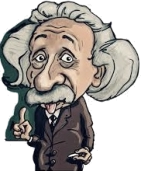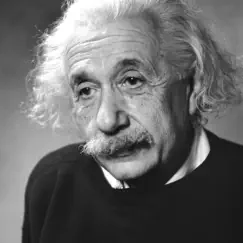


Magic Particles!
Think of a Number
Let’s see if Einstein can guess your chosen particle.
Ready?







Make sure you remember your number and click next:
First subtract 4 from 41, leaving 37
Simple!
Then subtract 1 from 37, leaving 36
First, think of any two digit number, such as 41.
Now, subtract the first and second digits from your number.
For example, if your number is 41:
Albert Einstein (1879 - 1955) was a theoretical physicist, best known for
his work on relativity. In 1905, sometimes referred to as the annus mirabilis
– the “miracle year” – he published four scientific papers which
revolutionized physics and our understanding of the universe:
The photoelectric effect: This is the emission of electrons from a material
when impacted by electromagnetic radiation, such as light. Einstein’s
breakthrough was to realize that a beam of light is not simply a wave
propagating through space, but is in fact a swarm of particles, called
photons, each acting as a tiny cannonball. The individual photons each have
a particular energy (based on their frequency), and this realisation is one of
the foundations of quantum physics, which in turn is the foundation of
quantum mechanics. It was largely this work that resulted in Einstein being
awarded The Nobel Prize in 1921 (and not Relativity, as is often thought).
Brownian motion: This describes the random motion of particles in a liquid or gas. It had been known since at least
1827 that pollen immersed in water displayed odd, random movements, sometimes moving a little and at other times
suddenly shooting off in a random direction. Einstein explained this by showing that the atoms in the water behaved
like billiard balls, mostly colliding with little energy, but sometimes with enough force to have a large impact, especially
if colliding with a much lighter object such as a pollen grain. This is often said to be the first definitive evidence that
atoms, previously only theorized, really exist.
Special Relativity: Probably Einstein’s best-known work, it redefined our understanding of how bodies are affected
when moving, especially when moving at a significant percentage of the speed of light. One of its strangest aspects is
that the speed of light in a vacuum is constant. This doesn’t seem so strange at first until it’s realized that the speed of
light is not relative to the movement of the observer. In short, what can be thought of as the “speed of time” changes
instead, leading to some highly surprising results, such as the Twin Paradox. Later, in 1915, Einstein published an
extension which is now called General Relativity, of which his earlier work was a component, or special part – hence it
now being known as “Special Relativity”.
Mass-energy Equivalence: Here, Einstein demonstrated that anything with mass has energy locked up in it, which
under certain conditions can be released. This is the basis of his famous equation E = mc
2
. You can see how Einstein
derived this equation here.
In a single year Einstein proposed or made great advances in at least three branches of physics that play important
roles in our lives today: the photoelectric effect (quantum mechanics – anything with a microchip in it), Brownian motion
(atoms and how they move and interact), and relativity (nuclear energy, and the small but necessary adjustments to the
clocks used in sat nav systems).
It’s important to note that in each case these discoveries weren’t just unstructured ideas or guesses, but instead were
based on mathematics that allowed predictions to be made and experiments to be carried out to confirm the results.
This is one of the foundations of how physics works as a science.
Now, head back to the top of the page and think of a number…


Quick and easy summaries of relativity and related subjects
[ Special Relativity ] [ General Relativity ] [ Einstein ] [ Time Dilation ]
[ Black Holes ] [ Twin Paradox ]


Magic Particles!
Think of a Number
Let’s see if Einstein can
guess your chosen particle.
Ready?





Make sure you remember your number and click next:
First subtract 4 from 41, leaving 37
Simple!
Then subtract 1 from 37, leaving 36
First, think of any two digit number, such as 41.
Now, subtract the first and second digits from your number.
For example, if your number is 41:










